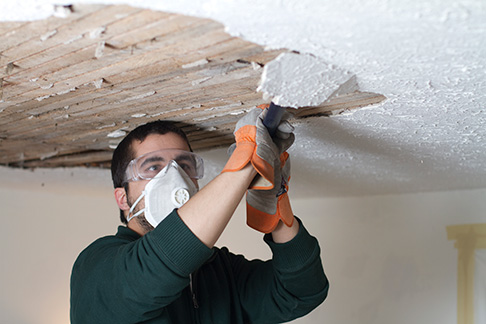Asbestos is a building material that was intended to insulate against cold and heat. Asbestos is made up of small fibres that if inhaled can lead to serious health problems. The substance was banned in 1999 as too much exposure of it was directly related to a form of lung cancer called mesothelioma and the fibres can leave lung scarring called ‘asbestosis’.
The highest risk for asbestos related illnesses in people, were those who worked in the asbestos industry. Over time, they developed illnesses as a result of being exposed to the substance, their families were at risk too as they could carry the hazardous fibres home on their clothes.
The material was used to build both homes and public buildings, so it is always best to bear in mind that your home may contain asbestos.
What do if you have suspicions?
The first rule if you suspect your home contains any ACM is not to disturb the substance. Disturbing it may cause the fibres to spread, increasing the risk of the fibres being inhaled. If you plan on renovating your home, it is advised to call in an asbestos surveyor who will perform an analysis on your home and notify you if it does indeed contain any ACM.
If the property is rented, it is a legal obligation of the landlord to have the property surveyed and provide the results.
Once a specialist has been called and their analysis comes back positive, they can remove the ACM, or if they suspect something does contain asbestos, they may take samples back. They can give you guidance on how to manage the suspect material until they have the results. In some cases, it is not practical to remove non-hazardous ACM from the home. In this event, a specialist will provide you with a management plan that will help you keep an eye on the condition.
How to identify asbestos
Unfortunately, there is no easy way to tell if your home contains asbestos. The physical appearance and colour of the substance can sometimes be a misgiving. When asbestos was manufactured, it was generally combined with other ingredients, so it removed the attributes of colour associated with types of asbestos.
There is however, one way to assess if your home contains asbestos. As the substance was banned in 1999, any house built after that year would be free of any ACM. The age of the house is an indicator, and areas to consider are ceiling linings, boundary fences, plumbing pipes, cement products or any building material that has not been moved since the building of the house.
Asbestos was also used in electrical equipment such as hair dryers and heating devices. While the possibility of them being able to function now may be low, it is still worth considering replacing them. Local councils have guidelines how to properly dispose of ACM.
In conclusion, asbestos is difficult to detect unless you have the right equipment. Find out how old the home is and if you do have any doubts or suspicions, contact a specialist immediately.
By Harry Price
Harry Price is a truly manly man. He enjoys researching and contributing to the latest technology research and going to the gym.
